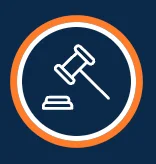Wheel stops, sometimes called parking blocks, car stops, or parking bumpers, are ever-present throughout the many commercial establishments in our state. These wheel stops are significant trip hazards because they are low to the ground, can be hard to see, and sometimes their placement is odd, strange, or unexpected. Especially for people who have difficulty walking or have other infirmities, a trip over a wheel stop can be devastating.
What is a Wheel Stop?
A wheel stop is a type of physical barrier used in parking lots to prevent vehicles from encroaching into pedestrian pathways or other restricted areas. Typically made from concrete, rubber, or plastic, wheel stops are positioned at the front of parking spaces and serve as a visual and physical cue for drivers to stop their vehicles within designated boundaries.
To maximize visibility and awareness, wheel stops are usually painted in colors that contrast sharply with the surface of the parking lot. This color differentiation helps both drivers and pedestrians recognize the boundaries of parking spots and avoid potential hazards. Common contrasting colors include white, yellow, or bright orange.
Safety Issues: Trip and Fall Accidents
Despite their intended purpose, wheel stops can pose safety risks, particularly for pedestrians. The placement of wheel stops near walking paths increases the likelihood of trip and fall accidents, leading to injuries that may range from minor bruises to more severe conditions requiring medical attention.
Factors contributing to these incidents include:
1. Proximity to Painted Lines: One of the primary concerns arises when wheelstops are positioned too close to the painted lines dividing parking spaces or even over them. Typically, individuals do not expect to encounter wheel stops in such proximity to these markings. As a result, pedestrians may inadvertently trip while navigating through the area, particularly if they are focused on their destination rather than the ground beneath them.
2. Narrow Pathways Between Wheel stops: In instances where two wheel stops are installed too closely together, the resulting walkway for pedestrians can become excessively narrow. This constriction increases the likelihood of a tripping incident, as individuals may find themselves squeezed between the wheel stops with limited space to maneuver. The unexpected tightness of this pathway can catch people off guard, leading to potential falls
3. Unanticipated Locations: Another dangerous scenario occurs when wheel stops are placed in pedestrian pathways where they are not expected. In these cases, pedestrians may not even be aware of the wheel stop’s presence, which can lead to serious accidents. The psychological expectation of an unobstructed path contributes to this risk; if a person does not anticipate encountering a wheel stop, their reaction time may be insufficient to prevent a fall.
Environmental Factors: Lighting conditions play a crucial role in pedestrian safety around wheel stops. Inadequate illumination can make it challenging for individuals to distinguish between the wheel stop and the surrounding ground, exacerbating the risk of tripping. Ensuring proper lighting in parking areas is essential not only for visibility but also for overall safety.
Maintenance Issues: The physical condition of wheel stops can also pose hazards. If a wheel stop is damaged, it can have protruding metal wires, often in the form of dislodged rebar meant to anchor the stop securely to the ground. These sharp edges represent a significant tripping and injury risk, emphasizing the need for regular inspections and maintenance.
Each year, hundreds or even thousands of individuals are injured by tripping over these obstacles. These trips can lead to a variety of injuries including ankle sprains, bruises, cuts, broken bones (fractures), head injuries, neck injuries, shoulder injuries, soft tissue damage, and in severe cases, spinal cord injuries depending on the impact and body part affected when falling.
Consult with Our Slip and Fall Greenville Lawyer
If you or someone that you know and love has been injured because of a wheel stop, contact Jordan Law Center today 864-808-1810 for a free consultation on your case.







“There is not enough GREAT THINGS I could say about Jordan Law Center.”